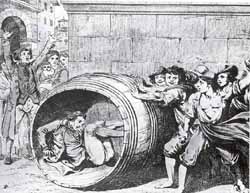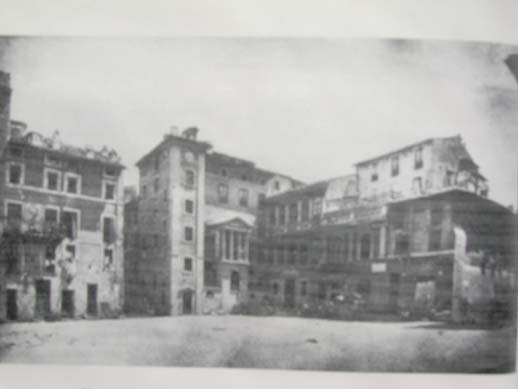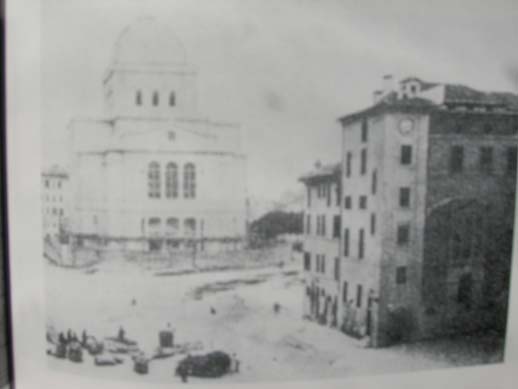|
|
 |
|
Jewish Ghetto and the Synagogue |
|
written
by kayanna / 10.03.2005 |
|
|
| |
Introduction |
| |
| |

|
| http://f_pollett.tripod.com/roma-c9.htm |
| Map of the Old Ghetto, circa 1676 |
| A map of the Jewish Ghetto. The circles show four gates. The left arrow points to the Pourch of Octavia. right arrow points to the small church of St. Gregory. |
| |
|
| |

|
| http://www.jewishvirtuallibrary.org/jsource/vjw/Rome.html |
| Treatment of Jews, Middle Ages |
| This picture is widely ascribed to be a representation of periodic treatment of Jews in Rome in the Middle Ages. |
| |
|
| |

|
| Theater of Acculturation, by Kenneth Stow |
| Cinque Scole |
| The 5 Temples. |
| |
|
| |

|
| Theater of Acculturation, by Kenneth Stow |
| View of the Ghetto |
| View of the Ghetto and the Ponte Fabricio from the Tiber River, around the turn of the Century. |
| |
|
| |

|
| Theater of Acculturation, by Kenneth Stow |
| Building of the Tempio Maggiore |
| The modern Ghetto area is being built around the synagogue. |
| |
|
The Tempio Maggiore and the current Jewish Ghetto area did not exist in their present form until the end of the nineteenth century, when the rules relegating Jews to that area and restricting religious freedom were lifted.
The history of the walled Jewish Ghetto began in 1555, but Jews lived in Rome since the reign of Emperor Titus, around 70 AD. There is evidence of the presence of Jews in Rome since 161 BC as envoys of Judah Maccabee, making this the oldest Jewish community in Europe. Other envoys came from Jerusalem in 150 and 139 BC, and after the sacking of Jerusalem in 63 AD, Jewish slaves were brought to Rome. Jewish delegates and merchants also began to come to Rome, and a permanent establishment began to grow. By the 8th Century, there were 12 or 13 synagogues in Rome. The way Jews were treated, from the adoption of Christianity by Roman emperors and during the Middle Ages, fluctuated from emperor to emperor and from Pope to Pope. Sometimes, they were forced to live outside the city walls. Synagogues were often burned down on official orders. Often, there were periods of frequent public tortures and humiliations.
Shortly following the Spanish Inquisition of the 15th century came the Roman Inquisition of the 16th century, begun by Pope Paul III in 1542. He established a body to safeguard the integrity of Catholicism and, while not as intense as the Spanish Inquisition, this period marked a steadily crumbling tolerance towards Jews in Rome.
There were several events leading up to the walling off of Jews in the Ghetto. On Rosh Hashannah (the Jewish New Year) of 1553, by order of Pope Julius III, copies of the Talmud were confiscated and publicly burned. Following Pope Paul IV's accession to the papacy in 1555, he ordered Jews to wear yellow veils and hats.
On July 12, 1555, Pope Paul IV issued his "cum nimis adsurdum" policy (when enough is enough), marking off an area of Rome on the east side of the Tiber meant to contain all the Jews of Rome. The reason for this action was not so much to keep the Jews away from Christians, but was rather to increase the likelihood of converting the Jews, although there was only an average of about 10 conversions per year. The Ghetto in Rome was the first Ghetto in Europe. The Ghetto in Rome likely took its name from the Jewish quarter of Venice. The walls of the Ghetto were finished in 2 months. The cost of the wall was exacted from the Jews in Rome. By July 26th, all Jews were moved into the Ghetto.
At the main entrance was the Piazza Giudea. The Portico d'Ottavia was the main gate into the Ghetto and was also near the Piazza Pescheria, formerly a fish market. The Portico d'Ottavia was erected by Augustus in 146 BC to honor his sister Octavia, and some of its columns are incorporated into the Sant'Angelo in Pescheria. The Portico pre-dated the Jews' existence in Rome, but this church was where many Jews were forced to hear Catholic sermons (although legend has it that many put wax in their ears to avoid hearing it). There was another gate at the Ponte Fabricio, a bridge built in 62BC that crosses the Tiber River. Most of the enclosure was building mass. Only a little wall was needed. Fragments of the wall still remain, attached to the Portico d'Ottavia.
Small piazzas riddled the Ghetto and were important for community and for information dissemination, since there were no synagogues in which to do so. All the synagogues were closed down, save one that was a merging of all of their previous synagogues into one. This synagogue was called the Cinque Scole, or 5-Temple Synagogue. It housed 5 schools of Italian Jewish practices (and some Sephardic after the Spanish Inquisition)- Roman, Lazian, Sicilian, Catalan, and Castillian. The Cinque Scole was moved outside of the enclosing wall in 1566 by order of Pope Pius IV.
Near this space, at the end of the Via della Reginella, was the Piazza Mattei. The Mattei family was the official gentile gatekeeper, and one set of gates was named for them. The Piazza Mattei still remains, with a few fragments of the original walled ghetto. In the middle of the piazza is the Fontana delle Tartughe (Fountain of the Tortoises), commissioned by and dedicated to the Mattei family. The fountain has additions done by Bernini. Between 1555 and 1848, this fountain was the only public fountain and clean water source for the public inside the Ghetto.
The conditions in the Ghetto were squalid. A high population density meant that large families lived in cramped apartments, usually heavily added on to with wood. Floods were frequent, as the ground level was below that of the nearby Tiber River. During the Plague between 1647-1650, the Ghetto was sealed off for 9 months. In 1824, with its population at its maximum, an extension to the Ghetto was added on the North end. At this point, there were 8 gates, which were the only points of entry. About 7,000 Jews lived within an area of 33,000 square meters, or about 4 city blocks. No building could exceed 5 stories, meaning that apartment space was severely limited and cramped.
Jews in Rome had to live under immense regulation between 1555 and 1848. Jews could not own land or the buildings they rented. They had to wear distinctive markings. They could not practice medicine with Christians. Christians were not allowed inside the gates. Jews were allowed to exit only after sunrise and required to re-enter before sunset. They could not engage in commerce, other than selling second-hand clothing. They could not make a profit, yet they had to pay higher taxes. The dead were buried in unmarked graves. There were Inquisition burnings in 1583. The Jews underwent forced baptisms, and were forced to convert. Pope Gregory XIII made attending masses mandatory in the late 1500s. If Jewish children were seen outside the gates, they were often kidnapped and forced to convert. The Talmud and other writings were confiscated and burned in the Campo de' Fiori. The community took to passing around one Talmud between families to lower the risk of confiscation, and each family would make notes in the margin to continue the tradition of scholarly dialogue.
On Passover of 1848, the walls of the Ghetto were razed during relief brought by Pope Pius IX, who abolished some of the Ghetto regulations. By 1849, however, the Ghetto regulations were reinstated.
On September 20, 1870, Italy became unified by Giuseppe Garibaldi. In 1885, the Ghetto was razed and rebuilt for reasons of public health and renewal. Many Jews began to move out of the area, and the Ghetto was absorbed back into Rome. After the Ghetto was leveled, it was rebuilt in a 20th-century block structure.
In 1893, the Cinque Scole, originally left standing, was burned by a fire. The construction of the new synagogue, the Tempio Maggiore, began shortly thereafter, and was completed July 28, 1904. A tablet commemorates King Victor Emmanuel III's visit to the synagogue in 1904.
Jews in the Ghetto experienced a period of respite from direct oppression until the German occupation of Italy. The Jews were at first protected by the Pope, but in 1943, Jews began to be deported to concentration camps. The area between the Portico d'Ottavia and the Tempio Maggiore was the site of Jewish deportation during German occupation in 1943.
Many Jews continue to live in the Ghetto area, although many are moving out due to rising rent prices. Some surnames visible on doorplates around the neighborhood are recognizable as Jewish, in existence in Rome since the first convoys. The surname Anav is said to be one of the first Jewish surnames present in Rome, and its Italian and Spanish variations include Delli Mansi, Almansi, Umani, and Piattelli. In addition, there were Levi's and Coen's present in these convoys, two of the oldest surnames in existence.
|
| |
|
| |
|
|
 |
|





